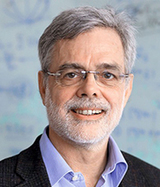On-line SPICE-SPIN+X Seminars
On-line Seminar: 16.09.2020 - 15:00 (CET)
Beyond Heisenberg Solids: From Multi-Spin Interactions to Novel Chiral Particles
Stefan Blügel, FZ Juelich

It became customary to study the stability, lifetime, dynamics, thermodynamics and transport properties of localized nanoscale magnetization particles such as skyrmionics by classical spin-lattice models with pairwise Heisenberg-type exchange interactions. The mapping of fermionic many-body systems onto a classical Heisenberg model is a nontrivial thing and by far not unique. In this presentation I motivate beyond Heisenberg multi-spin interactions [1]. I give examples, where these interactions play a decisive role [2]. I focus on MnGe in the B20- phase, which exhibits a three-dimensional spin-texture. We introduce a novel class of magnetic exchange interactions [3] – the topological-chiral interactions (TCI) rooted in the so- called topological orbital moment, which manifests as a result of finite scalar spin chirality in non-coplanar magnets. The long-wave length limit of the interactions relates to the highly acclaimed Faddeev model demonstrating that the interaction is an origin of 3D magnetization textures all the way down to hopfions.
[1] M. Hoffmann, S. Blügel, PRB 10, 024418 (2019).
[2] A. Krönlein, M. Schmitt, M. Hoffmann, J. Kemmer, N. Seubert, M. Vogt, J. Küspert, M. Böhme, B. Alonazi, J. Kügel, H. A. Albrithen, M. Bode, G. Bihlmayer, and S. Blügel, PRL 120, 207202 (2018).
[3] S. Grytsiuk, J.-P. Hanke, M. Hoffmann, J. Bouaziz, O. Gomonay, G. Bihlmayer, S. Lounis, Y. Mokrousov, S. Blügel, Nat. Commun. 11, 511 (2020).
PDF file of the talk available here


